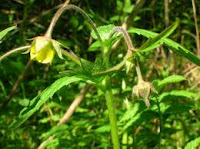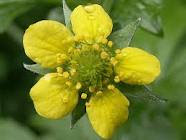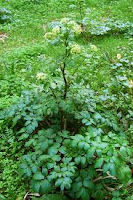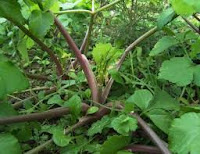The white willow is native to Europe including Britain Asia and some parts of North America , although it has mainly naturalized there, and in Connecticut
The white willow is famous as the original source of salicin used for aspirin, and the story goes that this was discovered by the Reverend Edmund Stone of Chipping Norton in the Cotswolds, Oxfordshire in 1763, although there are many other claims too.
Hippocrates (circa 400 BC) recommended willow bark to be chewed to reduce fevers and inflammation, and it has been used in traditional Chinese and European medicine for many centuries. It seems that the effect of the fresh or dried bark takes longer to kick in than aspirin, but the effects last longer.
Has this to say about the medicinal properties of the white willow: -
“Government and virtues. The Moon owns it. Both the leaves, bark, and the seed, are used to stanch bleeding of wounds, and at mouth and nose, spitting of blood, and other fluxes of blood in man or woman, and to stay vomiting, and provocation thereunto, if the decoction of them in wine be drank. It helps also to stay thin, hot, sharp, salt distillations from the head upon the lungs, causing a consumption. The leaves bruised with some pepper, and drank in wine, helps much the wind cholic. The leaves bruised and boiled in wine, and drank, stays the heat of lust in man or woman, and quite extinguishes it, if it be long used. The seed also is of the same effect. Water that is gathered from the Willow, when it flowers, the bark being slit, and a vessel fitting to receive it, is very good for redness and dimness of sight, or films that grow over the eyes, and stay the rheums that fall into them; to provoke urine, being stopped, if it be drank; to clear the face and skin from spots and discolourings. Galen says, the flowers have an admirable faculty in drying up humours, being a medicine without any sharpness or corrosion; you may boil them in white wine, and drink as much as you will, so you drink not yourself drunk. The bark works the same effect, if used in the same manner, and the tree hath always a bark upon it, though not always flowers; the burnt ashes of the bark being mixed with vinegar, takes away warts, corns, and superfluous flesh, being applied to the place. The decoction of the leaves or bark in wine, takes away scurff and dandrif by washing the place with it. It is a fine cool tree, the boughs of which are very convenient to be placed in the chamber of one sick of a fever.”
 This is the wisdom of the 17th century, but be careful not to overdose on it if you want to retain your libido (just in case)!
This is the wisdom of the 17th century, but be careful not to overdose on it if you want to retain your libido (just in case)! Other compounds apart from salicin have been identified in the bark, including some with antiseptic, immune-boosting, fever reducing and antioxidant properties. Salicin reduces inflammation and eases pain. The effects of the bark therefore may not be simply due to the salicin compound.
 Traditionally the bark of the white willow has been used to treat inflammation associated with gout, and given to asthma and diabetes patients, and for headaches. However conventional medicine practitioners do not agree with these treatments and suggest that it should not be used either for gout or asthma and neither should it be used by people suffering from haemophilia, gastritis, or stomach ulcers, or breastfeeding mothers and pregnant women. It should not be given t children under the age of 16.
Traditionally the bark of the white willow has been used to treat inflammation associated with gout, and given to asthma and diabetes patients, and for headaches. However conventional medicine practitioners do not agree with these treatments and suggest that it should not be used either for gout or asthma and neither should it be used by people suffering from haemophilia, gastritis, or stomach ulcers, or breastfeeding mothers and pregnant women. It should not be given t children under the age of 16. The dosage for adults is 1-2 teaspoons of the dried bark infused in 8 fluid ounces of water for 30 minutes, then strained; 3-4 cups of this can be drunk daily. This is to relieve inflammatory pain and headaches. It may also be used to reduce fevers.
 The decoction of the bark is very bitter and astringent because of the tannin content and may be used for diarrhoea and dysentery as well as to get rid of intestinal worms. The bark is best harvested from branches that are between 3 and 6 years old.
The decoction of the bark is very bitter and astringent because of the tannin content and may be used for diarrhoea and dysentery as well as to get rid of intestinal worms. The bark is best harvested from branches that are between 3 and 6 years old. An infusion of the leaves, which can be collected at any time during the growing season of spring through to early autumn, can be made for a calming effect and nervous insomnia, although it tastes very bitter and needs to be flavoured with honey or sugar.
The leaves may also be added to hot bath water to ease the symptoms of rheumatism. They can be used fresh or dried.
The bark sold in Europe is usually a mixture of the purple willow, the crack willow and the white willow.
The tree is also used to make paper, and a variant is used in Britain
This is called the white willow because the undersides of its leaves are silvery white, and when the sun shines on them when there is a breeze, the tree has a shimmering silvery sheen. The leaves are edible as are the young shoots but taste very unpleasant, as does the powder made from the inner bark which can be ground to flour and used for making bread in times of scarcity. It is a fast growing tree, but is not very long-lived, mainly because it is susceptible to a variety of pests and diseases.
It is a beautiful tree, with catkins in spring, and I have always liked this tree as I thought, because of its silvery sheen that it must have been inhabited by faeries.
















































